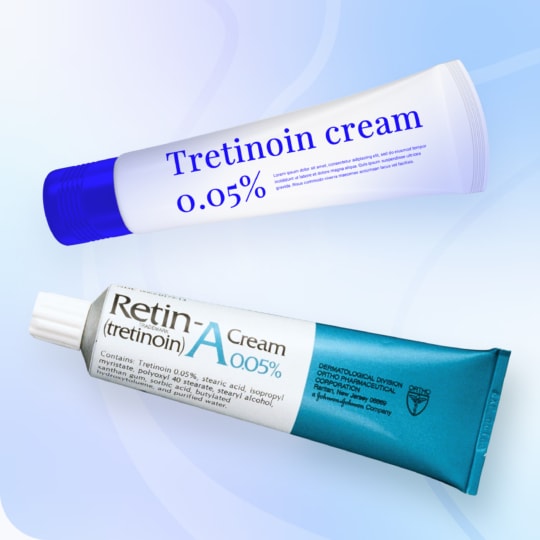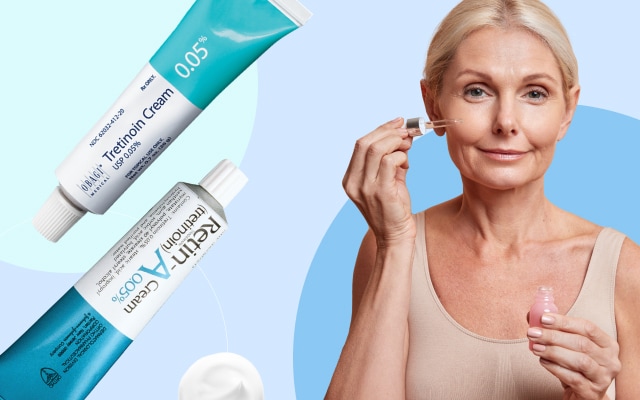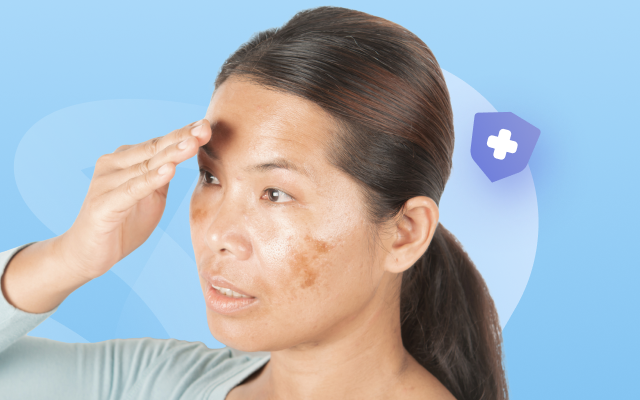Chemical peels for acne scars: Are they worth it?
Chemical peels are minimally invasive skin treatments that have been quite popular for several decades. But do they work for acne scars and are they worth the money? Keep reading to find out!
Table of Content:
What is a chemical peel? | Do they work for acne scars? | Types of peels for acne scars | Can I do peels at home? | How deep should the peels go? | What is the price of a peel? | How many peels do I need? | What is the recovery time? | Is there a more affordable solution? | How to get a prescription medicine for acne scars?
Our commitment to producing high-quality content:
The information presented in this article is based on scientific research and the professional advice of our Content Medical Reviewers, who are experts in the field of Dermatology. How we write our content →
So, what is a chemical peel?
Chemical peels (also referred to as chemical exfoliation) is a minimally invasive exfoliation procedure that involves applying a specific chemical solution to the surface of the skin to remove its top layers. They cause controlled destruction of the scarring tissue, with the formation of fresh and healthy skin cells during healing. As a result, the newly regenerated skin tends to be smoother in texture1.
In the United States, chemical peels are quite popular for the treatment of acne scars, post-inflammatory hyperpigmentation, melasma, and wrinkles.
However, depending on the severity of your condition, you may need to do several treatments and combine chemical peels for acne scars with topical acne treatment, and fractional laser therapy or ablative laser resurfacing to obtain the desired results.
Do chemical peels for acne scars work?
According to Dr. Alpana Mohta, board-certified dermatologists, yes, chemical peels can reduce the appearance of acne scars; in addition to this, chemical peels are also used to address hyperpigmentation or dark spots, photodamage and wrinkles2.
Does tretinoin work for acne scars?
Yes absolutely! Tretinoin works wonders for acne scars, especially if the scars are fairly new.
How to get a prescription for tretinoin for acne scars?
You can request a tretinoin prescription with a board-certified dermatologist via Miiskin which is only $59. The medication refill is only $39.
What types of chemical peels are used for acne and acne scars?
Dr. Mohta says that the combination of chemical peels, laser therapy, dermabrasion, and radiofrequency can be helpful for people with moderate to severe acne scarring. Chemical peels are often used alongside other acne treatments like retinoids, AHAs or BHAs to get the best results.
Salicylic Acid Peels
- Salicylic acid peels are highly effective for treating acne-prone skin
- They penetrate the pores and help dissolve sebum (skin oil) and unclog them, reducing the formation of acne lesions
- Often used to treat blackheads, whiteheads, and mild to moderate acne
Based on studies, the optimal strength of salicylic acid for treating acne scars is 30%, and it is recommended to undergo at least 3 to 5 times, spaced at intervals of 3 to 4 weeks, all conducted at a clinic3.
Glycolic Acid Peels
- Glycolic acid peels exfoliate the top layer of skin, promoting cell turnover, and reduce excess melanin from deeper layers of skin.
- They are widely used for the treatment of acne, acne scars, melasma, post-inflammatory hyperpigmentation, photoaging, and seborrhea and preventing new breakouts4
- Daily skincare involves lower concentrations, ranging from 5% to 15%
- For chemical peels, stronger concentrations of 30% to 70% are utilized and high-concentration peeling is exclusively performed in clinics
Lactic Acid Peels
- Lactic acid peels are more gentle, they exfoliate the skin’s surface and help to hydrate it
- They are often used to improve skin texture, address mild acne, acne scars and melasma in people with sensitive skin types.
Mandelic Acid Peels
- Mandelic acid peels have a larger molecular size, making it less irritating for sensitive skin
- They can be used to treat acne and post-inflammatory hyperpigmentation
Jessner’s Peel
- Jessner’s peel is a light to medium depth peel that contains salicylic acid, lactic acid, and resorcinol
- This peel can penetrate deeper into the skin and is used for severe acne and acne scars
TCA (Trichloroacetic Acid) Peels
- TCA peels are medium-depth peels that are typically used for acne scarring or other severe skin conditions
- They penetrate deeper into the skin to promote collagen production, which can help improve the appearance of scars.
Pyruvic Acid
- Pyruvic acid is a powerful peeling agent used exclusively in clinics due to its high concentration5
- It is effective against moderate to severe acne scars, offering benefits like even penetration, mild skin peeling, and a short recovery time
- It also promotes the production of new collagen and elastic fibers
Combination Peels
Some chemical peels may combine different acids to target multiple aspects of acne, such as exfoliation, unclogging pores, and reducing inflammation.
Can I do chemical peels for acne scars at home?
Dr. Mohta says that while there are some at-home chemical peel products available over-the-counter, it is not recommended to attempt chemical peels for acne scars on your own without professional guidance, especially if you are considering deep or more potent peels because you can seriously injure your skin.
How deep do chemical peels for acne and acne scars need to go?
Dr. Mohta says that for the treatment of acne, dermatologists will usually perform light chemical peels, but for the treatment of acne scars, they will need to perform medium to deep chemical peels.
For acne: Superficial or light chemical peels
These are the mildest types of chemical peels. They work by penetrating only the top layer of your skin. These types of peels are often used for mild skin issues, like fighting acne and improving skin texture. They have minimal downtime and are generally well-tolerated6.
The peel includes substances such as glycolic acid (<50%), lactic acid, mandelic acid, salicylic acid, and pyruvic acid7.
For acne scars: Medium or deep chemical peels
Medium peels go deeper than superficial peels. They are used to address more significant skin concerns, such as moderate wrinkles, uneven pigmentation, and certain types of acne scars. Medium peels typically require some downtime for recovery and may cause temporary redness and peeling8.
Deep peels are the most intensive type of chemical peel. They penetrate deeply into the skin. These peels are usually reserved for treating severe skin issues, like deep wrinkles, pronounced sun damage, and certain types of scars.
A medium or deep chemical peel, using ingredients like salicylic acid, glycolic acid, or TCA, can help improve mild to severe acne scars. These peels are applied in varying concentrations to the skin, potentially with a primer like Jessner’s solution9.
Due to their depth, deep peels often require a longer recovery period and can cause significant peeling, redness, and discomfort. They are typically performed under the supervision of experienced medical professionals10.
What is the price of a chemical peel?
The cost of a chemical peel treatment can vary significantly based on your state and the type of peel you choose. On average, a chemical peel typically costs around $500, but the price can be as low as $200 and as high as $5,000, depending on various factors.
How many chemical peels do I need for acne scars?
According to Dr. Mohta, in order to treat acne scars, you will typically need at least 3-5 sessions. However, the exact number will depend on the severity of your scars and how well your skin responds to the treatment.
A dermatologist in your area will need to assess your individual condition to make a tailor-made plan for you.
How long does it take to recover from a chemical peel and are there any risks involved in doing this?
Dr. Mohta says that the recovery time for your treatment depends on the depth of your peel. For example, a TCA Cross peel could entail a recovery period of up to 10 days, while a very mild glycolic acid or salicylic acid peel may not require any downtime whatsoever.
The most significant risks associated with doing chemical peels are potential hyperpigmentation and the possibility of developing additional scars. According to Dr. Mohta, the extent of these risks depends on the choice of the peeling agent. The stronger and deeper the peel, the higher the risk involved.
Lighter peels, such as glycolic, salicylic, lactic, and mandelic acid peels, carry a very minimal risk. However, with more intense options like phenol peels, Baker-Gordon phenol, and multiple layers of Jessener’s solution, both the risk and the recovery time increase significantly.
Are chemical peels for acne scars worth the money?
Dr. Mohta says that although chemical peels are quite effective in the treatment of acne scars, there are other treatments that you can do that may be more or at least equally effective to get rid of acne scars such as laser resurfacing, dermabrasion, microneedling radiofrequency (MNRF), vampire facial, soft tissue fillers or botox11.
Is there a more affordable alternative to improve the appearance of acne scars?
If you have a limited budget, Dr. Mohta recommends you start with topical treatment such as prescription retinoids (such as tretinoin, adapalene or tazarotene) and AHAs like glycolic acid or lactic acid and wait for results. For hyperpigmented acne spots, skin-lightening ingredients (such as hydroquinone and azelaic acid) are good at-home options.
If you do not experience improvement after 6 to 12 months, you can have a consultation with a local dermatologist so they can suggest a treatment plan that fits your needs and your budget.
Popular ingredients usually prescribed for acne scars
- Tretinoin
- Glycolic acid
- Salicylic acid
- Lactic acid
- Mandelic acid
- Niacinamide
- Hydroquinone
- Azelaic acid
- Kojic acid
- Vitamin C
- Poly hydroxy acid (PHA)
So, how to get a prescription for these medicines?
You can have a photo-consultation with a dermatologist, which starts at $59. You will need to answer some questions about your condition and upload a photo of your skin.
After your online dermatologist reviews your case, they will write you a prescription for a customized formula that will include some of the ingredients listed above. This formula will vary depending on the severity of your condition and the type of skin you have.
The takeaway
A consultation with a dermatologist will help you decide what is the best course of action for your acne scars. Starting with topical treatment may help you improve your skin’s texture, depending on the severity of your condition, and to obtain your desired results you may need a combination of different treatments. Finding a dermatologist in your area can help you achieve radiant skin.
Article References:
https://www.ncbi.nlm.nih.gov/books/NBK547752/
https://www.ncbi.nlm.nih.gov/pmc/articles/PMC4445894/
https://www.ncbi.nlm.nih.gov/pmc/articles/PMC3875240/
https://www.ncbi.nlm.nih.gov/pmc/articles/PMC2958495/
https://www.ncbi.nlm.nih.gov/books/NBK547752/
https://www.ncbi.nlm.nih.gov/pmc/articles/PMC6122508/
https://www.ncbi.nlm.nih.gov/pmc/articles/PMC2921757/
https://www.ncbi.nlm.nih.gov/pmc/articles/PMC6122508/
https://www.ncbi.nlm.nih.gov/pmc/articles/PMC2921757/
https://www.mayoclinic.org/diseases-conditions/acne/expert-answers/acne-scars/faq-20058101
Skin conditions and treatments
Articles written in collaboration with dermatologists
Facial treatment for seborrheic dermatitis
How to get rid of rosacea permanently?
How to calm a rosacea flare-up fast?
Spongiotic dermatitis: What is it and what is the best treatment?
A dermatologist’s guide to psoriasis medication






